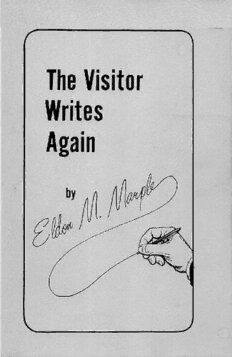
The Visitor writes again PDF
Preview The Visitor writes again
The Visitor Writes Again by The Visitor Writes Again by ©The Country Print Shop 1984 Reproduction in any manner. except as authorized by the Copyright Act, is prohibited. All rights reserved. Printed by The Country Print Shop. Inc. Hayward, Wisconsin 54843 Printed in the United States of America 2 FOREWORD The course of history is like an hour-glass, the sliding sands slowing momentarily while pouring through the constricted area of our present understanding, the broad-based triangle of the past being re arranged to form the equally expanded future. What lessons we can learn from the grains of sand as they pause in our consciousness depends upon what we glean from them of the effect !hay had on past events, so that we can use this knowledge to guide the course of our future. Historians stand between the two triangles; sorting, sifting and recording; then presenting their findings for the use of those who may have need for them. This book is the fourth in a series compiled mostly from articles originally published individually in The Visitor - each tells the story of a feature of the community: its geography or geology, the logging of the forests and the settlement of the cutover, the development of industry, and of those persons whose work has been notable in initiating or recording each phase. They are woven from hundreds of notes garnered from many sources: old newspapers, pictures, maps, graveyards, censi, oldtimers and even contemporary historians. Although it is necessary to fill out the bare facts with many words to make the story informative and readable, every effort has been made to present it in phrases which interpret what is obvious from the evidence available. The Northwestern part of the state of Wisconsin, centered around the Hayward Lakes Region, is the locale for these stories. The subject matter is of the Indians, lumbermen, land dealers, settlers and resorters who have lived and worked here, mostly of the era between 1880 and 1920, telling of the impact of each upon our land, our forests and our community. 3 We wish to give credit to the State Historical Society of Wisconsin for the use of pictures and informational papers. Also to the Sawyer, Washburn and Bayfield County Societies who have given us the same consideration. We must thank the people who have helped us gather information and who have allowed us to use their pictures: Merle Dunster, Phyllis DeBrot, Hans Horne, Elsie Slater Lee, Mary Trepania, Matrin Lee, John Anderson, Katie Dennis, Tony Wise and many others. An extra credit must be given to Mary Marple whose grammatical sense has smoothed some of the rough spots in composition and whose presence has eased some of the many miles traveled while compiling these articles; and to Connie Miller whose unstinted support has encouraged us to continue this enterprise. 4 CONTENTS OLD TRAILS AND NEW SETTLEMENTS THE ANCIENT NAMEKAGON VALLEY TRAIL 10 TRADING POST ON THE WEST FORK 15 FRENCHTOWN ON THE CHIPPEWA 21 THE NATIONAL REGISTER OF HISTORIC PLACES 27 CONSERVATION THE HAYWARD ROD AND GUN CLUB 35 TOTOGATIC LAKE - WILDERNESS PARADISE 39 EDDY CREEK - TROUT STREAM WITH A PAST 45 SETTLERS IN THE CUTOVER WHAT USE FOR THE CUTOVER - THE TREE OR THE PLOW 49 THE WISCONSIN COLONIZATION COMPANY 55 NORTHWOODS BEACH - THE "WISE SUBDIVISION" 61 CHITTAMO - A CROSSROAD IN FROG CREEK COUNTRY 65 RAILROADS IN THE TALL TIMBER HAYWARD'S CENTENNIAL AND THE NAMEKAGON VALLEY RAILROAD 69 LOGGING HARDWOOD AND HEMLOCK BY RAIL 73 TALE OF TWO FORGOTTEN RAILROADS 79 HARNESSING THE RIVERS DAMS AND WATERPOWER IN THE LOGGING DAYS 87 "WHEN THE DAM BROKE" - A COMMUNITY'S DILEMMA 93 SOCIABLE MAN MURDER WILL OUT 101 LEGEND OF THE BLUE HILLS HERMIT 103 THE GLORIOUS FOURTH! 105 THE STORY BEHIND THE PICTURE HISTORIC VIGNETTES OF BUILDINGS. ARTIFACTS, PEOPLE. TRAVEL AND VALLEYS 111 MILEPOSTS OF HISTORY INDEX OF SOME HISTORIC FEATURES OF THE NORTH COUNTRY 137 5 6 INTRODUCTION Each one of us, in our own time, dreams of passing on a memory, a lesson learned or a set of traditions. Historians through the ages have dedicated themselves to preserve our pasts in books. Through patient research we have been able to penetrate the veils of time and use its lessons to anticipate where the future may lead us. It has been said that hindsight is 20/20. perhaps we can use this clearer perception to interpret the problems of the future. The four Marple books are chronicles of Sawyer County history, an area of delicate beauty and bounty. The slim volumes start with the pre-human geological past and continue to the early 1900's. This most recent edition is probably my favorite. It is pleasingly lyrical, adding peotic beauty to the standard historical tome. Thank you, Eldon and Mary and all of those others who helped them perserve our past. Andrea Marple Wittwer 7 8
